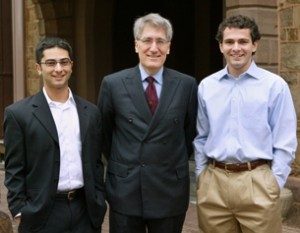 Chapter three addresses the interest of the state with respect to marriage. Girgis, Anderson and George put the matter simply:
Chapter three addresses the interest of the state with respect to marriage. Girgis, Anderson and George put the matter simply:
The universal social need presented by relationships that can produce new, dependent human beings explains why every society in the history of our race has regulated men and women’s sexual relationships: has recognized marriage (39).
These relationships alone produce new human beings. For these new and highly dependent people, there is no path to physical, moral, and cultural maturity without a long and delicate process of ongoing care and supervision—one to which men and women typically bring different strengths, and for which they are better suited the more closely related they are to the children. Unless children do mature, they will never become healthy, upright, productive members of society; and that state of economic and social development we call “civilization” depends on healthy, upright, productive citizens. But regularly producing such citizens is nearly impossible unless men and women commit their lives to each other and any children they might have. So it is a summary, but hardly an exaggeration, to say that civilization depends on strong marriages (38).
The reason marriage is regulated by the state is therefore on account of the long-term common good of the society and culture as a whole. As such, marriage is more than a personal arrangement designed to address personal issues; it is a social institution developed to solve a social problem: the care of children that the mere desire for children and the sex that makes children possible, does not solve. Although marriage is universal in practice, however, it is also fragile and costly, requiring a strong marriage culture. Indeed, people “tend to require social pressures to get and stay married” (39).
By regulating marriage entry and exit, and by helping and sometimes requiring the government as well as individuals and civic institutions to treat certain couples as a unit, marriage law sends a strong public message about what it takes to make a marriage—what marriage is. This in turn affects people’s beliefs, and therefore their expectations and choices, about their own prospective or actual marriages (41, original emphasis).
Having argued that marriage is a social institution, the authors go on to argue that it is fitting that the state regulate marriage in order to facilitate society-wide coordination and support of this public good. This regulation of conjugal marriage, however, “need not and should not involve prohibiting any consensual relationship” (42). The aim is to support this vision of what marriage is, not restrict the liberties and relationships of those seeking other forms of relationship.
When considering the social benefits of this particular relationship, the authors suggest that “common sense and reliable evidence both attest to the facts that marriage benefits children, benefits spouses, helps create wealth, helps the poor especially, and checks state power” (42). Citing and utilising numerous research studies, they detail the evidence for each of these claims though also acknowledging that, “obviously, none of this is to suggest that any marriage is perfect or that spouses never fail to live up to their vows. We are speaking here in generalities, in light of the accumulated social-scientific evidence” (117).
The final section of the chapter addresses the criticism that “marriage is not a naturally generated institution with certain essential elements,” but has been “constructed over time” and reflects “larger social power relations” (117). Obviously the authors have already argued that marriage is a basic human good with certain distinguishing and naturally inherent characteristics. They do recognise that the specific characteristics of marriage differ between one period and another, and that other marital forms such as polygamy and arranged marriages have existed in many cultures. Such variations do not invalidate their central claims:
No moral truth of much specificity has enjoyed universal assent … It is natural rather to think that the most basic ethical principles would be most widely held; while those derived from more basic principles would meet with patchier understanding and assent. … What [the conjugal view] considers most basic to marriage—like bodily union and connection to family life—are nearly universal in marriage practice. And what it and our argument treat as grounded in these basics—permanent, exclusive commitment—is less represented (48-49, original emphasis).
For the several thousand years that we have records of philosophical and legal traditions, sexual intercourse between men and women has been regulated. Other forms of sexual intimacy have never been recognized as consummating a marriage, while other matters such as infertility or old age do not void the relationship. “The law [in western traditions over 2400 years] reflected the rational judgment that unions consummated by coitus were valuable in themselves, and different in kind from other bonds” (50).
If it is the case that marriage is simply an endlessly malleable social construction, there is no natural right to marriage that existing laws violate by being defective, and if it is considered just to extend those laws to include other forms of relation, it would be unjust not to recognize other relations such as polyamorous unions unless there were clear and heavy social costs to including them (50-51). Nevertheless, the authors suggest that most advocates on both sides of the current debates reject constructivism. “They agree that marriage has certain necessary features. They only disagree on whether sexual complementarity is one” (52).